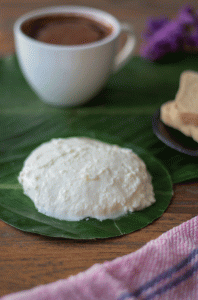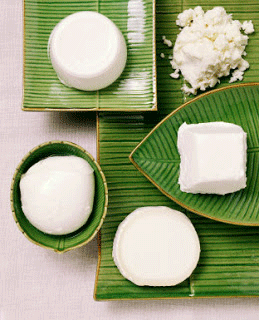When I was a kid and we were living in Quinchia, a small town in the department of Risaralda, one of my mother’s first concerns every day was what time will the milk arrive from the farm? It’s not surprising as she had to plan her daily chores, including having to feed five children. One of those tasks was to make queso fresco, a very simple soft cheese, with no fermentation, ideal for a morning breakfast with arepa (grilled flat cornbread) and hot chocolate. In this agricultural community nothing was wasted, she even made her own butter.
 Colombian fresh cheese is similar and, in my opinion, practically the same as Mexican queso fresco. It’s a very easy cheese to make since all you have to do is add some type of acid to the milk for it to curdle, then you strain it and that’s it. After this my mother would then wrap the cheese with banana leaves, the same ones we use to make Colombian tamales. This adds a delicious aroma to the cheese.
Colombian fresh cheese is similar and, in my opinion, practically the same as Mexican queso fresco. It’s a very easy cheese to make since all you have to do is add some type of acid to the milk for it to curdle, then you strain it and that’s it. After this my mother would then wrap the cheese with banana leaves, the same ones we use to make Colombian tamales. This adds a delicious aroma to the cheese.
Some of our European friends get surprised by what seems to be a very limited variety of cheese in the country. You may see a whole supermarket aisle full of queso fresco, queso blanco and queso campesino, which all seem to be the same to a European palate used to cheddar, camembert, and gorgonzola! There are subtle differences though, some of them regional, and well-appreciated by locals – queso campesino is usually firmer and a little drier than the others.
There are other typical Colombian cheeses though. Questo costeño, originating on the Caribbean coast, is a delicious salty crumbly cheese, similar to feta but generally made from cows milk. Queso pera, popular in Boyaca, an inland region not far from Bogota, is so named because of its pear shape, quite firm but still served fresh rather than matured. It is often described as Colombian mozzarella, but to me it could also be compared with Edam – in texture at least.
Lovers of hard, mature strong-tasting cheese also need to look to the Boyaca region, where there are a number of artisan cheesemakers producing cheeses which are popular in the excellent fresh food markets in Bogota. Queso Paipa is a very good example, it is usually made with the milk from Normandy cows, and can be compared with Gruyere – delicious!


Recent Comments